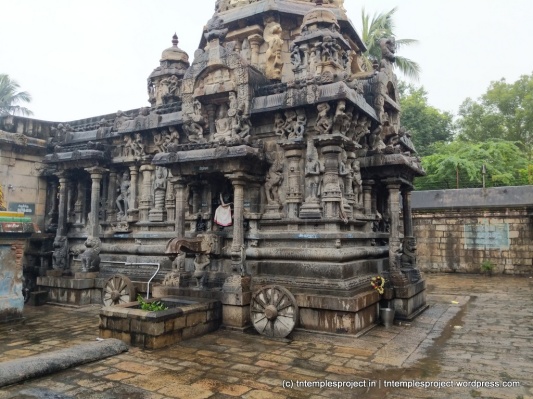Basic information about the temple
| Moolavar: | Amritakadeswarar | Ambal / Thayar: | Jothiminnammai |
| Deity: | Siva | Historical name: | Tirukkadambur |
| Vriksham: | KaDamba Maram | Teertham: | Sakti Teertham |
| Agamam: | Age (years): | Timing: | 7.30 to 10 & 5.30 to 7.30 | Parikaram: |
| Temple group: | Paadal Petra Sthalam (Kaveri Vada Karai) | – | |
| Sung by: | Temple set: | ||
| Navagraham: | Nakshatram: | ||
| City / town: | Mela Kadambur | District: | Cuddalore |
| Maps from (click): | Current location | Mayiladuthurai (24 km) | Kumbakonam (43 km) |
| Ariyalur (63 km) | Tiruvarur (65 km) |
Location
Sthala puranam and temple information
After the churning of the ocean, the Devas obtained the divine nectar and started consuming it, without worshipping Vinayakar, who is normally worshipped before any auspicious event. Angered by this, Vinayakar took away the pot of nectar. As he left Tiruparkadal, a drop of the nectar fell here, and became a swayambhu murti Lingam. Later, after much pleading, and of course worship of Vinayakar, Indra and the Devas were told by Vinayakar to worship Siva here. Responding to their prayers, Siva gave them the nectar, and stayed here. Therefore, Siva here is called Amrita Kadeswarar (referring to the pot of nectar), and the place is called Kadambur also after the kadam or pot of nectar (similar to Tirukadaiyur).

In a puranam reminiscent of the one at Chayavaneswarar temple at Sayavanam, Indra’s mother used to come here every day to worship Siva. In order to make it easier for her to do so, and fuelled by his ego, Indra wanted to take this temple, along with all the deities, to Devalokam, in a splendid chariot. But neither did he worship, nor have the permission of, Vinayakar to do so. To teach Indra a lesson, the Vinayakar at this temple held back the chariot by its left wheel, preventing it from leaving this place. The temple is built like a chariot, and this incident is vividly portrayed – one can see the left wheel of the chariot buried slightly in the ground.
Indra realised his folly and his penance – as recommended by Vinayakar – was to install one crore Lingams. But every Lingam that he tried to install would get damaged. So Indra prayed to Siva, who instructed him to make just one Lingam, while chanting the Panchakshara mantram one crore times. This effort was successful, and this Lingam that Indra created is installed in the Rudra Koteeswarar temple at nearby Keela Kadambur. It is believed that even today, Indra performs puja at this temple every day.
Literary sources mention 9 types of structural temple construction – Perunkoil, Karakkoil, Gnazharkoil, Kudikoil, Ilankoil, Manikoil, Alakoil, Madakoil and Poonkoil.
The sthala puranam of the temple indicates that this temple has been present across the four yugams. Chandran worshipped here in the Krita yugam, Indra in Treta yugam, Parvatarajan (Himavan) and his 8 family deities in the Dwapara yugam, and Patanjali in Kali yugam. There are inscriptions and images depicting each of these, in the temple.
The present structural temple is Chola, dates back to the early 12th century, from the time of Chola king Kulothunga Chola I (prior to this, it was made of brick and mud). The temple is one of very few examples remaining, of the Karakoil type of construction, where the garbhagriham is shaped like a chariot being pulled by horses. In the late 19th century, after the temple had seen a lot of neglect and dilapidation, the temple was renovated by members of the Nagarathar community. (It is said that one Arunachalam Chettiar of Devakottai had collected the stones necessary to renovate the Tirukoodalatriyur temple, but was asked by Siva in a dream, to renovate this temple instead.)
Despite being a relatively small temple, the architecture here is so extensive and exquisite, that it deserves a separate post. However, some key features are mentioned here. There is virtually no empty space on the outer walls of the garbhagriham, with almost every square inch taken up by carvings, murtis, bas relief images or other work, depicting various puranams of the temple, of Siva, and the lives of the 63 Nayanmars. Dakshinamurti is crafted with great precision, and the vimanam above the koshtam also depicts Dakshinamurti in three different forms. The temple also houses a Chola bronze of Dasa Bhuja Rishabha Tandavamurti (Siva with 10 arms, dancing, on the Rishabham), which is brought only for pradosha puja, every fortnight.

The moolavar is housed on an octagonal avudai, and is believed to be carved out of Navapashanam (in Siddha procedure, this is a compound of 9 poisonous substances). It is also believed that the Navagraham worshipped Siva here, and this puranam is honoured by adorning the moolavar in clothes of different colours, representing the Navagraham planets.
The Aaravara Vinayakar in the traditional southwest corner of the temple, is said to have been brought from the North by Rajendra Chola, after his victory over the Ganga dynasty (another version states it was brought from Vatapi). This is the Vinayakar said to be connected with the sthala puranam of the temple. Murugan – as Villendhiya Velavar – is seen with a bow instead of the traditional spear; this is said to represent his visit and worship here prior to his battle with Soorapadman.
Kadambur itself is mentioned in the temple inscriptions, and is called Uttama Chola Chaturvedi Mangalam. Readers of Ponniyin Selvan, the magnum opus of Kalki, may recall Kadambur as the place where several important events of the story take place.
Other information for your visit
Keela Kadambur, an ASI site, is located 1.5km from this temple, and is home to the temple of Rudra Koteeswarar, referred to in the sthala puranam above.
Contact
Selva Ganesan Gurukkal: 97156 39212
Phone: 93456 56982
Gallery
























[…] Amritakadeswarar, Mela Kadambur, Cuddalore (11.4 km) […]
LikeLike